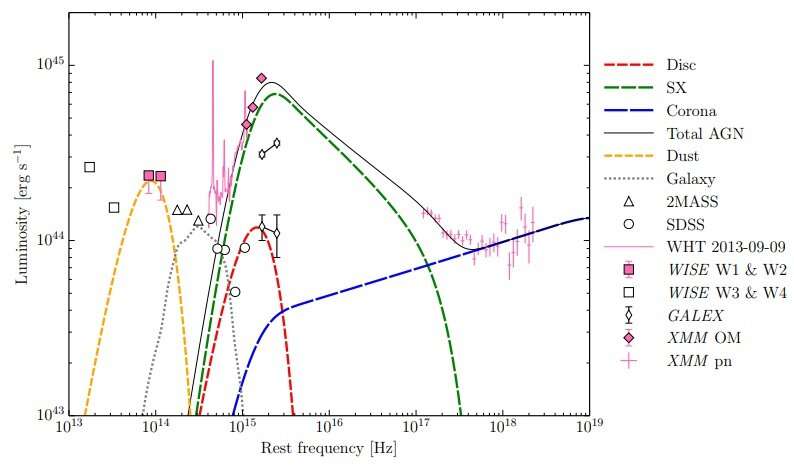February 26, 2019 report
Astronomers investigate extreme variability of the 'Big Dipper' active galactic nucleus

Astronomers have carried out an observational campaign to study the extreme variability of the active galactic nucleus (AGN) SDSS J2232−0806, nicknamed the Big Dipper. Results of these observations, described in a paper published February 18 on the arXiv pre-print server, shed some new light on the nature of this variability.
AGNs are compact regions at the center of galaxies, more luminous than surrounding galaxy light. They are very energetic due either to the presence of a black hole or star formation activity at the core of the galaxy.
Significant multi-frequency variability on many timescales is one of the characteristic features of AGNs. However, mechanisms behind this variability are still a subject of debate. Among the proposed explanations are changes in the dust extinction, changes in the emission from the accretion disc or its associated Comptonisation regions, stellar tidal disruption, supernovae in the nuclear regions, and even gravitational microlensing.
In order to resolve these uncertainties, more studies of the properties of AGN variability are required. One such study was conducted by a team of astronomers led by Daniel Kynoch of Durham University, U.K., using various ground-based telescopes. The researchers performed an optical photometric and spectroscopic monitoring campaign of SDSS J2232−0806 to investigate its variability. The Big Dipper is an AGN at a redshift of 0.276 and was initially classified as a "slow-blue nuclear hypervariable" object.
"Here, we report an analysis of the eleven optical spectra obtained to date, and we assemble a multiwavelength dataset including infrared, ultra-violet and X-ray observations," the astronomers wrote in the paper.
Observations conducted by Kynoch's team recorded one major dimming event and subsequent rise over a period of around four years. Moreover, archival photometry data indicate similar events taking place in the past.
The researchers noted that SDSS J2232−0806 appears to have been in a relatively bright state when observed in late 1980s, but was in a deep minimum in the data from observations conducted in 2000. Furthermore, lightcurve from the Catalina Sky Survey (CSS) suggests that another dip occurred between 2005 and 2007.
Analysis of the collected data allowed the team to exclude the extrinsic cause of the observed variability of SDSS J2232−0806. They concluded that the object's variability is most likely due to an intrinsic change in the luminosity of the accreting matter. It could be a result of an intrinsic variation in the continuum emission from the nuclear region, primarily powered by processes occurring within the accretion disc.
Although the researchers were unable to determine the exact origin of variability of SDSS J2232−0806, they hope that future observations could answer this question. "SDSS J2232−0806 is one of a growing number of objects which challenge our models of viscous accretion discs. Whilst we are unable to determine the cause of the intrinsic luminosity change, X-ray and UV monitoring of future episodes should greatly improve our understanding of the processes at work," the scientists concluded.
More information: Daniel Kynoch et al. The 'Big Dipper': The nature of the extreme variability of the AGN SDSS J2232-0806 arXiv:1902.06753 [astro-ph.GA]. arxiv.org/abs/1902.06753
© 2019 Science X Network





















